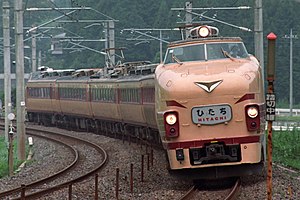485 series
| 485 series | |
|---|---|

An original "bonnet-style" 485 series train on a Joban Line Hitachi service in August 1998
|
|
| In service | 1964–present |
| Manufacturer | Hitachi, Kawasaki Heavy Industries, Kinki Sharyo, , Nippon Sharyo, Tokyu Car Corporation |
| Constructed | 1964–1987 |
| Refurbishment | 1999–2006 |
| Scrapped | 1985 (481 series) |
| Operator(s) |
JNR (1964–1987) JR East (1987–present) JR-West (1987–2011) JR Kyushu (1987–2015) |
| Line(s) served | Various |
| Specifications | |
| Car body construction | Steel |
| Car length | 20 m (65 ft 7 in) |
| Maximum speed | 120 km/h (Normal) 130 km/h (Kosei Line) 140 km/h (Tsugaru-Kaikyō Line) |
| Traction system | Resistor control |
| Electric system(s) |
|
| Current collection method | overhead catenary |
| Bogies | DT32, TR69 |
| Braking system(s) | Dynamic brake, electro-pneumatic brake |
| Safety system(s) | ATS-S, ATS-P, ATC (485-3000 series only), Tobu ATS (Nikkō set only) |
| Track gauge | 1,067 mm (3 ft 6 in) |
The 485 series (485系 Yonhyaku-hachijūgo-kei?) (and the earlier 481 and 483 series variants) is a Japanese limited express electric multiple unit (EMU) type introduced in 1964 by Japanese National Railways (JNR), and subsequently operated by the East Japan Railway Company (JR East), West Japan Railway Company (JR-West), and Kyushu Railway Company (JR Kyushu). Approximately 1,500 vehicles were built, although by April 2016, JR East is the only operator still using this type.
The 481 series trains were introduced in 1964 for use on Hokuriku Line limited services, and were capable of operating under 1,500 V DC or 20 kV AC (60 Hz) overhead wire power supplies. These train were subsequently operated by JR-West and JR Kyushu.
A 481 series trainset on a Midori service circa 1982
481 series Green car SaRo 481-1051 in 1985
481 series restaurant car SaShi 481-52 in 1985
Interior of SaShi 481-40 restaurant car in 1985
The 483 series trains were introduced in 1965 for use on Tohoku Main Line limited express services, and were capable of operating under 1,500 V DC or 20 kV AC (50 Hz) overhead wire power supplies. The non-powered trailer cars used in these sets were classified 481 series.
The 485 series trains were introduced in 1968. These trains were capable of operating under 1,500 V DC or 20 kV AC (50/60 Hz) overhead wire power supplies. The original design was closely based on the bonnet-style 181 series EMU, with the primary difference being ceilings that were 12.5 cm higher. However, trains produced from 1972 onwards, starting with the 485-200 series, featured a new design with a cab adapted from the 583 series sleeper expresses, which became the standard on nearly all subsequent JNR limited-express EMUs. The 485-200 series trains had gangway doors at the cab ends to allow trains to be operated in multiple, but the 485-300 series trains introduced from 1974 had no gangways. The 485-1500 series trains were built in 1974 for use in Hokkaido. The 485-1000 series trains built from 1975 onward incorporated design improvements from the DC-only 183-1000 series trains.
...
Wikipedia
